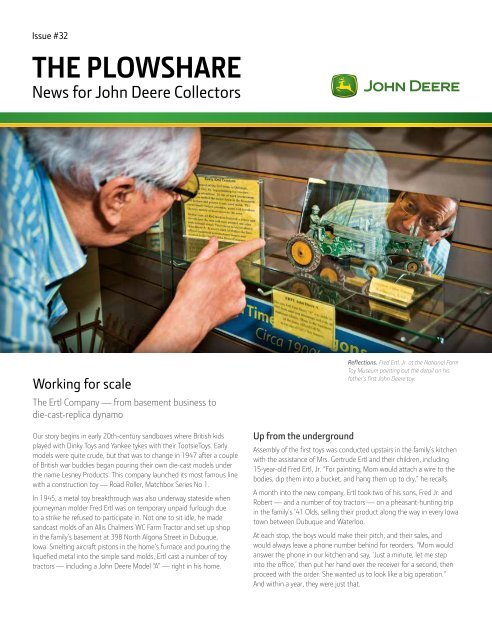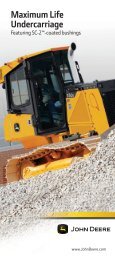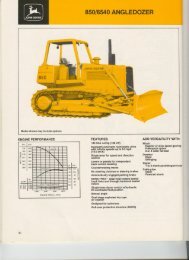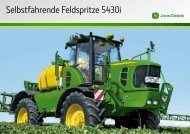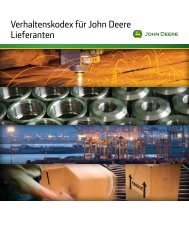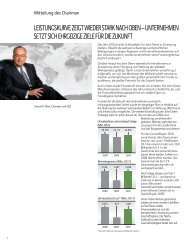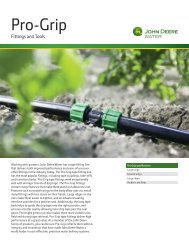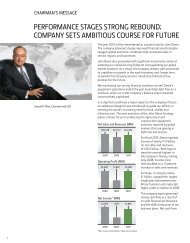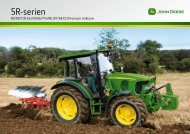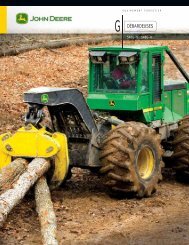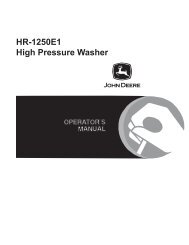Create successful ePaper yourself
Turn your PDF publications into a flip-book with our unique Google optimized e-Paper software.
Issue #32<br />
<strong>THE</strong> <strong>PLOWSHARE</strong><br />
News for <strong>John</strong> <strong>Deere</strong> Collectors<br />
Working for scale<br />
The Ertl Company — from basement business to<br />
die-cast-replica dynamo<br />
Our story begins in early 20th-century sandboxes where British kids<br />
played with Dinky Toys and Yankee tykes with their TootsieToys. Early<br />
models were quite crude, but that was to change in 1947 after a couple<br />
of British war buddies began pouring their own die-cast models under<br />
the name Lesney Products. This company launched its most famous line<br />
with a construction toy — Road Roller, Matchbox Series No 1.<br />
In 1945, a metal toy breakthrough was also underway stateside when<br />
journeyman molder Fred Ertl was on temporary unpaid furlough due<br />
to a strike he refused to participate in. Not one to sit idle, he made<br />
sandcast molds of an Allis Chalmers WC Farm Tractor and set up shop<br />
in the family’s basement at 398 North Algona Street in Dubuque,<br />
Iowa. Smelting aircraft pistons in the home’s furnace and pouring the<br />
liquefied metal into the simple sand molds, Ertl cast a number of toy<br />
tractors — including a <strong>John</strong> <strong>Deere</strong> Model “A” — right in his home.<br />
Up from the underground<br />
Reflections. Fred Ertl, Jr. at the National Farm<br />
Toy Museum pointing out the detail on his<br />
father’s first <strong>John</strong> <strong>Deere</strong> toy.<br />
Assembly of the first toys was conducted upstairs in the family’s kitchen<br />
with the assistance of Mrs. Gertrude Ertl and their children, including<br />
15-year-old Fred Ertl, Jr. “For painting, Mom would attach a wire to the<br />
bodies, dip them into a bucket, and hang them up to dry,” he recalls.<br />
A month into the new company, Ertl took two of his sons, Fred Jr. and<br />
Robert — and a number of toy tractors — on a pheasant-hunting trip<br />
in the family’s ’41 Olds, selling their product along the way in every Iowa<br />
town between Dubuque and Waterloo.<br />
At each stop, the boys would make their pitch, and their sales, and<br />
would always leave a phone number behind for reorders. “Mom would<br />
answer the phone in our kitchen and say, ‘Just a minute, let me step<br />
into the office,’ then put her hand over the receiver for a second, then<br />
proceed with the order. She wanted us to look like a big operation.”<br />
And within a year, they were just that.
Fred Ertl, Jr. poses in front of his Dubuque childhood<br />
home, where his father cast the first Ertl toys.<br />
An immediate hit<br />
Within a year, The Ertl Company had moved<br />
out of the basement and started working<br />
closely with <strong>Deere</strong> & Company designing,<br />
manufacturing, and marketing farm toys. A<br />
year after that, an 18-year-old Fred Ertl, Jr.<br />
took over the reigns of the company from<br />
his ailing father.<br />
Welcome to the “Farm Toy Capital<br />
of the World”<br />
It turned out the younger Fred did The Ertl<br />
Company proud, presiding over a move to<br />
nearby Dyersville in 1959 and the worldwide<br />
expansion of a toy company that would make<br />
products for fun and collecting, ranging from<br />
tractors to motor graders, and from pedal cars<br />
to the Duke boys’ General Lee.<br />
The customer base would also grow from<br />
farm kids to adults bitten by the collectible<br />
die-cast-replica bug that started ramping up<br />
in the 1970s and turned into a worldwide<br />
phenomenon. Ertl changed from a toy<br />
company to a corporation building products<br />
for people to enjoy from cradle to grave.<br />
Also enjoying growth is Dyersville, a town<br />
known for the “Field of Dreams” and as the<br />
Farm Toy Capital of the World. Not only is<br />
Ertl located there but also two of the largest<br />
annual farm-toy shows and the National<br />
Farm Toy Museum, which offers thousands of<br />
visitors a year a glimpse of scale-model Olivers,<br />
Fordsons, and every <strong>Deere</strong> tractor imaginable.<br />
And it all started with a big idea in a tiny<br />
basement.<br />
Ertl #2. This <strong>John</strong> <strong>Deere</strong> Model “A” Tractor,<br />
circa 1946, was cast either in his family’s<br />
basement or at the first Ertl plant in Dubuque.<br />
One year to make a lifelong memory<br />
We spoke with <strong>John</strong> <strong>Deere</strong> Construction & Forestry Manager of<br />
Events and Promotions David Althaus about how long it takes to<br />
get a construction equipment replica to <strong>Deere</strong> dealers and retail<br />
outlets. The short answer is one year. The longer answer is:<br />
2
A <strong>John</strong> <strong>Deere</strong> employee with a link to <strong>Deere</strong>’s 1837 plow<br />
Duane Crandall, service delivery manager at the<br />
<strong>John</strong> <strong>Deere</strong> North America Parts Distribution Center,<br />
has a connection to <strong>John</strong> <strong>Deere</strong>’s first plow.<br />
Duane Crandall was just a kid<br />
romping around his grandpa’s farm<br />
when he first heard the story of how<br />
<strong>John</strong> <strong>Deere</strong> came to test out his first<br />
plow on Crandall family land. The<br />
story has been part of family lore<br />
for more than 175 years.<br />
“It’s hard to believe my family was part<br />
of that history,” he said as he drove a golf<br />
cart down the long aisles of the <strong>John</strong> <strong>Deere</strong><br />
North America Parts Distribution Center in<br />
Milan, Illinois, where he works as a service<br />
delivery manager.<br />
His ancestors lived near pioneering blacksmith<br />
<strong>John</strong> <strong>Deere</strong> in 1837, across the river from<br />
his Grand Detour, Illinois, shop where he<br />
built his first self-scouring plow. The family’s<br />
connection to <strong>Deere</strong> was especially important<br />
to Crandall’s grandpa, Charles Crandall, who<br />
was a part-time farmer and full-time machinist<br />
at <strong>John</strong> <strong>Deere</strong> Harvester Works. He retired in<br />
the early 1970s and died in 2005 at age 100.<br />
A new approach to farming in<br />
the Old West<br />
Like other settlers of the early 1800s, the<br />
Crandall’s had no trouble with the initial<br />
breaking of the prairie sod. It was the<br />
subsequent plowing seasons that turned<br />
the soil black and gummy. It got so a man<br />
had to rein in his team every few feet, scrape<br />
the sticky soil off the plowshare, then get his<br />
team moving again.<br />
Many settlers were discouraged from this<br />
seemingly insurmountable problem, and some<br />
even considered heading back East. But when<br />
<strong>Deere</strong> was visiting the Grand Detour Hydraulic<br />
Mill and spied the glint from a broken and<br />
discarded steel saw blade that was polished<br />
by thousands of strokes cutting through heavy<br />
timbers, he had one of the most brilliant ideas<br />
of the century.<br />
<strong>Deere</strong> fashioned a plowshare out of the blade<br />
and polished it even further so even the<br />
stickiest soil would slide off. So he had the<br />
idea and the prototype; now all he needed<br />
was a test farm. Enter the Crandall’s.<br />
12<br />
months out<br />
11<br />
months out<br />
9<br />
months out<br />
7<br />
months out<br />
Product marketing managers<br />
meet to decide which models<br />
to replicate.<br />
TOMY/Ertl starts receiving<br />
Pro/E files of prototype<br />
machines from <strong>Deere</strong>.<br />
<strong>Deere</strong> C&F receives white<br />
styrene tooling model from<br />
TOMY/Ertl.<br />
The “first shot” — an<br />
unpainted version of the replica<br />
is ready for <strong>Deere</strong>’s review.<br />
3
A 176-year-old mystery is…solved?<br />
It seems clear <strong>Deere</strong> tested his new-style<br />
plow on Crandall family land, but no one<br />
knows for sure exactly where the plot was<br />
located or which Crandall owned it. Duane<br />
Crandall agrees with the research uncovered<br />
by self-described “hobby genealogist” Susan<br />
Littlefield Haines, also a Crandall descendant.<br />
Haines studied the family line for more than<br />
two years, tracing the land back to Luke<br />
and Deborah Crandall. Her research shows<br />
the couple owned 200 acres of land and a<br />
ferryboat that crossed the Rock River to Grand<br />
Detour near Mr. <strong>Deere</strong>’s fledgling blacksmith<br />
shop. Haines said she believes <strong>Deere</strong> loaded<br />
his plow on that ferry and tested his plow on<br />
the couple’s property.<br />
To add even more credence to Haine’s theory,<br />
the Crandall’s were former neighbors of <strong>Deere</strong><br />
in Rutland, Vermont, and immigrated to the<br />
Grand Detour area in 1835, less than two<br />
years before <strong>Deere</strong> moved west to the area.<br />
Grandpa Crandall’s homecoming<br />
Duane Crandall said he wishes he could<br />
tell his grandpa what he’s learned about the<br />
family legend. He said his grandfather stayed<br />
connected to Grand Detour and even built<br />
a subdivision on some of his farmland in the<br />
area. He stayed loyal to <strong>John</strong> <strong>Deere</strong>, too. <br />
“I remember my grandpa had a <strong>John</strong> <strong>Deere</strong><br />
Model ‘B’ built in 1936,” Crandall said. “It<br />
was a 2-cylinder and had a hand crank to get<br />
it started. My grandpa was really proud of<br />
our family’s <strong>John</strong> <strong>Deere</strong> connection, and it<br />
meant a lot to him that I was also working<br />
for the company.” <br />
When Charles Crandall was 95, Duane took<br />
his grandpa on a tour of Harvester Works.<br />
It was his first visit back since his retirement.<br />
“The tour guides treated him like royalty —<br />
it’s a great memory of mine. My family was<br />
connected at the very beginning, and look at<br />
the company now. <strong>John</strong> <strong>Deere</strong> is everywhere.”<br />
Duane Crandall enjoyed time with his grandpa,<br />
Charles Crandall. Both have deep roots in <strong>John</strong> <strong>Deere</strong><br />
dating back to 1837.<br />
A vintage Crandall family photo.<br />
3<br />
months out<br />
2<br />
months out<br />
★<br />
Completion<br />
The updated first shot is<br />
painted and decaled.<br />
Upon approval of deco<br />
model, the replica goes<br />
into production.<br />
Replicas arrive in <strong>John</strong> <strong>Deere</strong><br />
dealerships and other retailers.<br />
Check out the video at:<br />
www.<strong>John</strong><strong>Deere</strong>.com/ertl<br />
4
GARDEN PLOT FOR RENT, perfect for the 2014 growing season: Well-fertilized plot of<br />
rich, well-draining soil (should it ever rain again). Grows a tremendous crop of weeds of<br />
all varieties — even in drought conditions. Reason for rental: Owner failed to produce a<br />
crop…yet again.<br />
This is the ad I’d like to put in our local paper. As you may recall, I wrote in our last Plowshare<br />
issue how I wanted to grow a record-breaking plot of huge pumpkins this summer. Instead,<br />
it was a failure for the record books. I carefully planted the seeds, and the plants did seem to<br />
grow quickly — I figured all they needed was a little weeding and watering, and they’d grow<br />
into the biggest pumpkins ever.<br />
But Mother Nature just didn’t cooperate. She dispatched a bug infestation in June, and I<br />
didn’t catch it quickly enough. That cost me a few plants, but it wasn’t a total loss. Then<br />
she decided to turn off the water supply, and that was the beginning to the end of the crop.<br />
I just couldn’t haul enough water to keep them alive. What a cruel and painful end to my<br />
“great pumpkin” adventure.<br />
I must confess: I could have done more watering and crop inspections. All I remember from<br />
my childhood is my folks dropping the pumpkin seeds in the ground in the spring, and<br />
harvesting the bounty in the fall. Maybe they weeded once or twice, but that’s it…wait…<br />
maybe now that I think back, Mom often spoke about the hard work involved in tending a<br />
crop. Maybe she was trying to teach me about gardening. Maybe about life. Maybe I should<br />
have listened to her, huh?<br />
Despite all my best intentions, we have no giant pumpkins to scare anyone on Halloween, no<br />
pumpkins for pie, and no pumpkins for the table centerpiece. We’ll have to trek down to the<br />
local farmers’ market to buy pumpkins again this year.<br />
If you’re one of the successful gardeners or farmers in this world, I commend you on your<br />
talents. Innovations in machinery and technology help a lot, but it still takes time, patience,<br />
and skill to produce a crop. In this season of thanks, I’m hoping you’re enjoying your bounty,<br />
and praying every reader can be thankful for another great year. Until next time…<br />
Keep your hand on the throttle and your plow in the ground.<br />
Brian Holst<br />
Manager, <strong>John</strong> <strong>Deere</strong> Heritage Marketing<br />
5
<strong>THE</strong> <strong>PLOWSHARE</strong><br />
JOHN DEERE<br />
One <strong>John</strong> <strong>Deere</strong> Place<br />
Moline, Illinois 61265<br />
HeritageMarketing@<strong>John</strong><strong>Deere</strong>.com<br />
www.<strong>John</strong><strong>Deere</strong>.com<br />
You have received this publication due to your relationship with <strong>John</strong> <strong>Deere</strong>.<br />
The Plowshare is free and is distributed quarterly. If you don’t want to<br />
receive future issues, please call 515-267-3109, and ask to have your<br />
name removed from The Plowshare mailing list. We will then stop sending<br />
you The Plowshare, but you may continue to receive information about<br />
merchandise and upcoming events from <strong>John</strong> <strong>Deere</strong>.<br />
Founder <strong>John</strong> <strong>Deere</strong> inducted into<br />
Vermont Ag Hall of Fame<br />
More than 175 years<br />
after leaving Vermont,<br />
the founder of <strong>Deere</strong><br />
& Company has been<br />
inducted into the Vermont<br />
Agricultural Hall<br />
of Fame. <strong>John</strong> <strong>Deere</strong><br />
and five other Vermont<br />
natives were honored<br />
this summer in Essex Junction, Vermont, for<br />
their special contributions to agriculture.<br />
Vermont Secretary of Agriculture Chuck Ross<br />
presented <strong>Deere</strong>’s award to Brian Holst,<br />
heritage marketing and branded properties<br />
manager for <strong>Deere</strong> & Company. “This award<br />
is truly an honor for all of us,” Holst said. “For<br />
<strong>John</strong> <strong>Deere</strong> to still be receiving awards for his<br />
innovation, which helped make this company<br />
what it is today, says a lot about him and his<br />
commitment to those linked to the land.” <br />
<strong>Deere</strong> was born in Rutland, Vermont, in 1804.<br />
As a young man, he worked as an apprentice<br />
and proprietor in blacksmith shops in several<br />
towns before moving to Illinois and eventually<br />
founding <strong>Deere</strong> & Company. <strong>Deere</strong> will join<br />
about 60 others honored in the 11-year-old hall<br />
of fame for their lifelong commitment to agriculture,<br />
said Jackie Folsom, committee chair.<br />
Winners must also have displayed integrity<br />
and character, overcame adversity, inspired<br />
enthusiasm, and shared their experience with<br />
future generations, she said. “After reading<br />
multiple bios about Mr. <strong>Deere</strong>, it was very<br />
clear he had those characteristics, even if he<br />
displayed them mostly in the Midwest,” she<br />
said. “He showed real perseverance.”<br />
This spot in Hancock, Vermont, is thought to be<br />
the site of <strong>John</strong> <strong>Deere</strong>’s last blacksmith shop in<br />
Vermont before leaving the state in the winter<br />
of 1836.<br />
6


